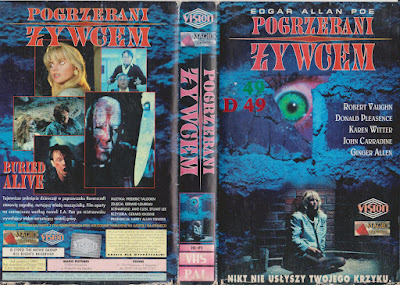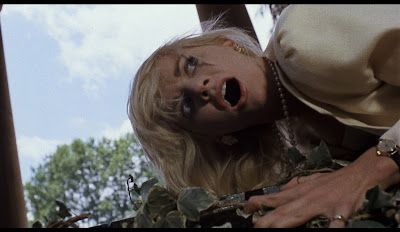(Spoilers) Not to be mistaken with Frank Darabont's directorial debut of the following year, the TV movie Buried Alive (trailer at the bottom of page), although it often is.
Trailer to
Gérard Kikoïne's Buried Alive:
Nope, this Buried Alive here, directed (not too shabbily) by the French porn and sexploitation director Gérard Kikoïne, is a production from the legendary Harry Alan Towers (19 Oct 1920 – 31 July 2009)! Born in London, Towers was a busy producer of exploitation films and mainstream product by the mid-1960s — two examples of the latter include Coast of Skeletons (1965) & Ten Little Indians (1965) — not to mention the happily married husband of one his former starlets, Maria Rohm (13 August 1945 – 18 June 2018), whose film career we looked at here.
Possessing a penchant for adapting (and re-adapting and re-re-adapting) copyright-free literary sources, in 1989, like Roger Corman decades earlier, Towers finally turned his attention to the works of Edgar Allan Poe and promptly produced three "Edgar Allan Poe" body-counters in South Africa: The Masque of the Red Death (1989, with Herbert Lom), The House of Usher (1989 / trailer), and this one here, Buried Alive. Whereas in the case of the first two movies Towers uses actual titles of Poe stories, in the case of Buried Alive, he simply slapped on the name Edgar Allan Poe to the movie's title. For, while people being buried alive does occur in multiple Poe tales, not one known Poe tale is actually titled "Buried Alive".
Which isn't to say that at least two Poe tales, if not three, don't raise their pinkies in this movie: the black cat that is seen time and again as an accessory red herring is a direct reference to The Black Cat (1843), which like The Cask of Amontillado (1846) includes immurement (as in: "live entombment"), a regular feature of this movie. Likewise, the way the lead character of Buried Alive, Janet Pendleton the Teacher (Karen Lorre, nee Witter, Playboy Playmate of the Month March 1982, below, of Popcorn [1991], Out of the Dark [1988 / trailer] and The Vineyard [1989 / trailer]), comes to Ravenscroft Institute, the school where the film is set, is possibly inspired ever so slightly by The Fall of the House of Usher (1839), while a big reveal waves hello to The System of Doctor Tarr and Professor Feather (1845). And, of course, where would Ravenscroft be without The Raven?
No one is ever actually "buried alive" in Buried Alive (immurement is the preferred method), though in the case of one victim, Debbie (American institution Ginger Lynn, regular co-performer of Harry Reems), she does get cemented alive up to her neck. And while the concept of immurement might not be a method of death one immediately links to the concept of a body-counter, which are generally known for "creative deaths", some of the other plentiful deaths are rather "creative": one girl gets a hand mixer through the top of her skull, another person has his brains boiled by electroshock, and one dies by cement trowel — the deaths, in other words, vary. And, as is evident from the first death — of a young girl who doesn't succeed at running away from Ravenscroft — the film doesn't shy away from delivering some late-80s violence and visceral, not to mention an occasional strobe light in the background.
For that, oddly enough, the movie's other staple of the 80s, the nude group shower scene, is amazingly chaste: shot mostly from the back, there is only one full frontal of decidedly average-sized man-tranquilizers. Unluckily, they are not those of the decidedly cute Nia Long, who, at the age of 19, made her feature-film acting debut in this movie and outshines all the other notably older "girls" in every scene she is in.
To put it bluntly, Buried Alive is a surprise: it is a relatively well-made, engrossing movie and an entertaining body-counter, nicely and lightly spiced with some cheese. It is very much a gothic suspense flick, and while it looks and is 100% late-80s/early-90s in setting, it could have easily been set in a turn-of-the-century lady's boarding school (ala Brides of Dracula [1960, with Kate O'Mara], for example, or any number of Italian Gothics from the 50s to the 70s) with bodices and flowing nightgowns instead of its quasi-WIP setting with bad hair. Indeed, in what is surely a nod to the movie's obvious roots, Buried Alive even has a singular scene of Janet wandering around the Ravenscroft manor in a white, flowing nightgown — most of the time, however, she is dressed in a sensible, leg-emphasizing skirt suit.
Janet, damaged goods, comes to Ravenscroft as a way of escaping her past. Why she feels trapped or what she's running from, we missed, but a lecture given by Ravencroft's director Dr Gary Julian (Robert "Teenage Caveman" Vaughn [22 Nov 1932 – 11 Nov 2016] of Battle Beyond the Stars [1980 / trailer], Starship Invaders [1980 / trailer] and Zombie 5: Killer Birds [1988 / trailer]) inspires her to join the staff of Ravenscroft as a teacher, a job that is possibly a bit too demanding for her.
Once Janet is at her new job, Dr. Julian proves to be a decidedly pre-#MeToo employer who is obviously out for a relationship with his new, shapely employee, while she herself, indecisive and tranquilizer-popping, starts to suffer from regular, highly realistic, and horrific hallucinations. As one girl after the other "runs away", her suspicions grow that something might be rotten in the state of Denmark — especially after she learns that her weird coworker Dr. Schaeffer (a wonderfully quirky Donald Pleasence [5 Oct 1919 – 2 Feb 1995] of The Monster Club [1981], Prince of Darkness [1987], Raw Meat [1972], The Freakmaker [1974], Django Strikes Again [1987] and so much more) is a former patient of Ravenscroft from when it was a nuthouse...
For most of the movie, the killer usually appears in a Ronald Reagan mask, so there is a microscopic hint of political statement, but in the end, the actual narrative development of Buried Alive is pretty much devoid of any message at all and, in general, makes about as much sense as any given plotline of yesteryear's Italian Gothics — in other words, hardly any — which oh-so-often featured this or that nanny or teacher or governess coming to some house of supernatural and/or horror and experiencing all sorts of illogical stuff until the less than logical resolution. And the resolution of Buried Alive is sure an illogical zinger, if enjoyably so.
But till then, other fun stuff happens aside from just dead girls. Like the groovy, terrifying hallucinations that Janet soon begins to suffer, the reason for which are never explained: she just starts having them, and they just happen to be closely linked to the horrific events occurring in the house. Dr. Schaeffer, forever lurking and watching, is, like the black cat, an obvious if enjoyable red herring with an oddly indefinable relationship to Dr. Julian; his sudden interference in the big final is definitely out of character, though it does at least allow for another fun death.
Who the killer ends up being is hardly surprising, but the appearance of that person's father, played by John Carradine ([5 Feb 1906 – 27 Nov 1988] of The Monster Club [1981], Vampire Hookers [1978], Shock Waves [1977], The White Buffalo [1977], House of Frankenstein [1944] and so much more) in his truly short, last feature-film role, is somewhat head-scratching: the viewer is never sure whether Daddy is simply a hallucination or the real thing. (Still, his appearance does allow for a fabulous final scene, one which would have been a typically stupid, final-shock film scene were it not just so wonderfully WTF that it becomes ironic and brilliant.)
Let's be blunt: Buried Alive is no undiscovered masterpiece. Indeed, it hardly even qualifies as a good movie. That said, it has girls & gore & mystery & dark hallways & breathing walls & ants & bad and quirky and even good acting & a game cast of cult names & rotting corpses & a lot of cheese, the last of which seems to be improving with age. A big minus is, of course, that despite director Gérard Kikoïne's past in the production of hand-helping visual aids, the movie is surprisingly devoid of nudity, especially when you consider that Ravenscroft is a girls-only reform school. But even without a bevy of bouncing breasts, the movie is still unexpectedly watchable in an unabashedly grindhouse way, and makes for an easy and painless 90 minutes of genre entertainment. Expect little, and you might even enjoy it — we did.
Oh, yeah: and keep your eyes open for an early appearance of an unrecognizable Arnold Vosloo, as well as of William Butler, the latter of whom went on to direct and/or write trashy films like Madhouse [2004 / trailer], Demonic Toys: Personal Demons (2010 / trailer), The Gingerdead Man (2005 / trailer), Return of the Living Dead: Necropolis (2005) & Return of the Living Dead: Rave to the Grave (2005 / trailer).
As an extra — the trailer to
Frank Darabont's Buried Alive:
















No comments:
Post a Comment